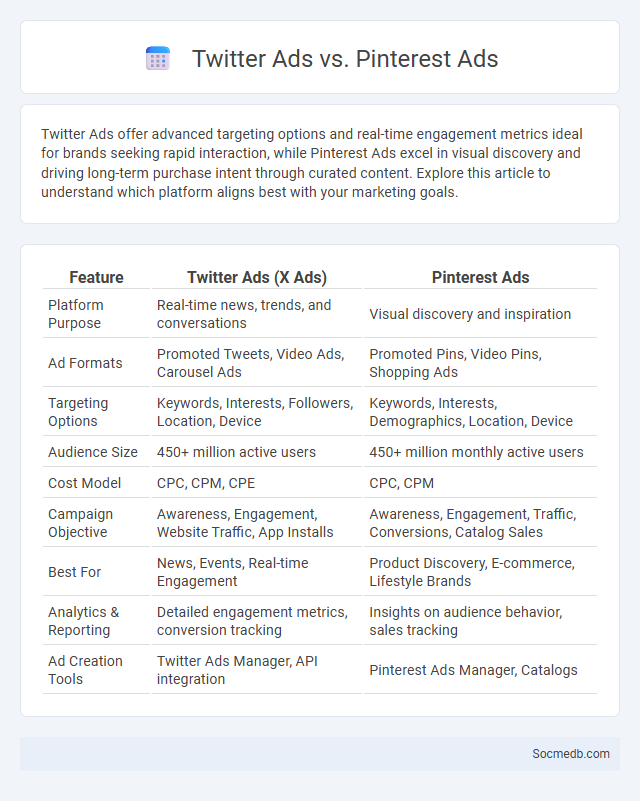
Photo illustration: Twitter Ads vs Pinterest Ads
Twitter Ads offer advanced targeting options and real-time engagement metrics ideal for brands seeking rapid interaction, while Pinterest Ads excel in visual discovery and driving long-term purchase intent through curated content. Explore this article to understand which platform aligns best with your marketing goals.
Table of Comparison
| Feature | Twitter Ads (X Ads) | Pinterest Ads |
|---|---|---|
| Platform Purpose | Real-time news, trends, and conversations | Visual discovery and inspiration |
| Ad Formats | Promoted Tweets, Video Ads, Carousel Ads | Promoted Pins, Video Pins, Shopping Ads |
| Targeting Options | Keywords, Interests, Followers, Location, Device | Keywords, Interests, Demographics, Location, Device |
| Audience Size | 450+ million active users | 450+ million monthly active users |
| Cost Model | CPC, CPM, CPE | CPC, CPM |
| Campaign Objective | Awareness, Engagement, Website Traffic, App Installs | Awareness, Engagement, Traffic, Conversions, Catalog Sales |
| Best For | News, Events, Real-time Engagement | Product Discovery, E-commerce, Lifestyle Brands |
| Analytics & Reporting | Detailed engagement metrics, conversion tracking | Insights on audience behavior, sales tracking |
| Ad Creation Tools | Twitter Ads Manager, API integration | Pinterest Ads Manager, Catalogs |
Introduction to Social Media Advertising Platforms
Social media advertising platforms such as Facebook Ads, Instagram Ads, Twitter Ads, and LinkedIn Ads enable businesses to target specific audiences with precision using demographics, interests, and behaviors. These platforms offer diverse ad formats including photo, video, carousel, and story ads to maximize user engagement and conversion rates. By leveraging real-time analytics and optimization tools, advertisers can efficiently track campaign performance and adjust strategies to achieve higher return on investment (ROI).
Overview of Twitter Ads
Twitter Ads enable businesses to reach targeted audiences through promoted tweets, accounts, and trends, leveraging Twitter's extensive user base of over 300 million monthly active users. Campaigns can be tailored using precise targeting options such as demographics, interests, keywords, and device type, optimizing engagement and conversion rates. Advanced analytics provide real-time insights into ad performance, allowing advertisers to refine strategies and maximize return on investment.
Overview of Pinterest Ads
Pinterest Ads offer businesses a powerful platform to reach over 450 million active users by promoting visually engaging Pins that align with users' interests and search behavior. The advertising formats include Promoted Pins, Video Pins, Carousel Ads, and Shopping Ads, all designed to drive brand awareness, website traffic, and conversions. With advanced targeting options such as interest targeting, keyword targeting, and customer lists, Pinterest Ads enable precise audience segmentation and performance tracking through their Ads Manager dashboard.
What is a General Ad Campaign?
A General Ad Campaign on social media targets a broad audience to increase overall brand awareness and engagement. It utilizes diverse ad formats such as images, videos, and carousel ads to promote products or services across platforms like Facebook, Instagram, and Twitter. Your goal with a General Ad Campaign is to maximize reach and drive traffic without focusing on a specific niche or demographic.
Audience Targeting: Twitter vs Pinterest vs Ad Campaign
Audience targeting on Twitter leverages real-time user behavior and trending topics, enabling precise demographic and interest-based campaigns for your brand. Pinterest's visual discovery platform focuses on intent-driven targeting, reaching users actively planning purchases or seeking inspiration in niches like home decor and fashion. Comparing ad campaigns, Twitter excels in engagement-driven strategies, while Pinterest offers higher conversion potential through keyword and interest alignment.
Ad Formats and Creative Options Comparison
Social media platforms offer diverse ad formats including image ads, video ads, carousel ads, and sponsored posts, each designed to engage different audience behaviors. Creative options vary significantly, with platforms like Instagram favoring visually striking stories and reels, while LinkedIn prioritizes professional content and lead generation forms. Choosing the optimal ad format and creative style depends on campaign objectives, whether aiming for brand awareness, engagement, or conversions.
Cost and Budgeting: Twitter Ads vs Pinterest Ads
Twitter Ads typically require a higher minimum daily budget, starting at around $5 per day, while Pinterest Ads offer more flexible budgeting options with minimum spends as low as $2 per day. The average Cost Per Click (CPC) on Twitter ranges between $0.50 to $2.00 depending on targeting, whereas Pinterest Ads generally achieve a lower CPC, often between $0.10 to $1.50, making them more cost-effective for niche audiences. Marketers should consider these cost differences alongside campaign goals, as Twitter's broad audience may demand higher spend for engagement, while Pinterest's visual discovery platform provides affordable options for driving traffic and conversions.
Performance Metrics and Analytics
Performance metrics and analytics in social media provide critical insights into user engagement, reach, and conversion rates, enabling businesses to optimize content strategies effectively. Key metrics include click-through rates (CTR), follower growth, engagement rate, and sentiment analysis, all tracked through platforms like Facebook Insights, Twitter Analytics, and Google Analytics. Leveraging these data points allows marketers to measure campaign success, identify audience preferences, and improve return on investment (ROI) by making data-driven decisions.
Pros and Cons of Each Advertising Platform
Facebook offers extensive targeting options and a vast user base, making it ideal for brand awareness and lead generation; however, its declining organic reach and increasing ad costs can challenge small businesses. Instagram excels in visual storytelling and engagement, especially for younger audiences, but the platform's algorithm changes may reduce ad visibility and effectiveness over time. Twitter provides real-time interaction and viral potential, yet it often requires frequent posting and can face limitations in targeting precision compared to other platforms.
Choosing the Right Platform for Your Marketing Goals
Selecting the ideal social media platform for your marketing goals requires analyzing your target audience's demographics, preferences, and behaviors to ensure maximum engagement and ROI. Platforms like Instagram excel for visual content targeting younger users, while LinkedIn is more effective for B2B marketing and professional networking. You should align your content strategy with each platform's unique features and algorithm to amplify your brand message and achieve measurable results.
 socmedb.com
socmedb.com